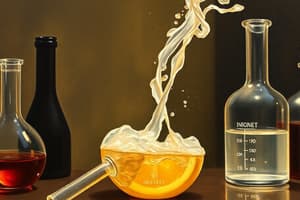Podcast
Questions and Answers
What is produced when an acid is placed in water?
What is produced when an acid is placed in water?
- Hydroxide ions (OH-)
- Hydronium ions (H3O+) (correct)
- Conjugate base
- Proton (H+)
Which statement correctly defines a Bronstead Lowry acid?
Which statement correctly defines a Bronstead Lowry acid?
- It is a substance that can accept a proton (H+)
- It is a proton (H+) donor (correct)
- It resists changes in pH
- It is a substance that releases hydroxide ions (OH-)
What does a buffer solution primarily resist?
What does a buffer solution primarily resist?
- Increases in solubility
- Changes in temperature
- Changes in pH (correct)
- Dilution
What is the characteristic of diprotic acids?
What is the characteristic of diprotic acids?
What does the term 'conjugate base' refer to?
What does the term 'conjugate base' refer to?
Flashcards are hidden until you start studying
Study Notes
Acids and Bases
- Acids produce hydronium ions (H3O+) when placed in water.
- Bases produce hydroxide ions (OH-) when placed in water.
- Strong acids and bases dissociate completely (100%) in water.
- Weak acids and bases dissociate partially (less than 100%) in water.
Brønsted-Lowry Acids and Bases
- A Brønsted-Lowry acid is defined as a proton (H+) donor.
- A Brønsted-Lowry base is defined as a proton (H+) acceptor.
- An acid-base reaction is a proton transfer reaction.
Conjugate Acids and Bases
- Any pair of molecules or ions that can be interconverted by transfer of a proton (H+) is called a conjugate acid-base pair.
- The conjugate acid is formed when a proton (H+) is added to a base.
- The conjugate base is formed when a proton (H+) is removed from an acid.
Amphoteric Substances
- Amphoteric substances can act as both acids and bases.
pH
- pH is a measure of the acidity or basicity of a solution.
- pH = -log[H3O+]. Lower pH values indicate higher acidity.
Ion Product of Water (Kw)
- In pure water at room temperature, the ion product of water (Kw) is 1.0 x 10-14.
- Kw = [H3O+][OH-]
Buffer Solutions
- A buffer solution resists a change in pH when limited amounts of acid or base are added.
- Buffer solutions commonly consist of a weak acid and its conjugate base.
- The maximum amount of acid or base that can be added before the buffer stops working is the buffer's capacity.
Indicators
- Indicators are substances that change color at a specific pH.
Polyprotic Acids
- Monoprotic acids can give up only one proton (H+). Example: HCl
- Diprotic acids can give up two protons (H+). Example: H2SO4
- Triprotic acids can give up three protons (H+). Example: H3PO4
Studying That Suits You
Use AI to generate personalized quizzes and flashcards to suit your learning preferences.



